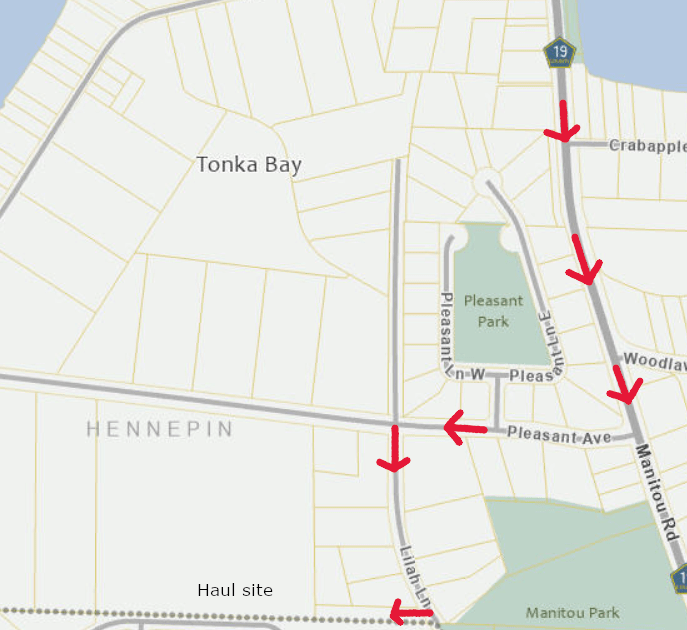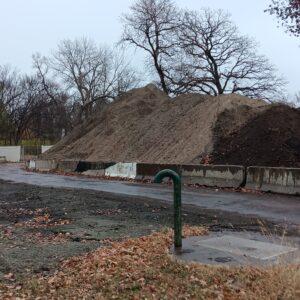Background: For those reading about the massive dirt pile in the Tonka Bay City Hall parking lot for the first time, it has been a tense subject for months. The soil is from the Brentwood water-street project and parts of Pleasant Avenue. The city learned that the soil is designated as a “sacred” Native American burial site. The Minnesota Indian Affairs Council (MIAC) and several other agencies, plus state laws, have jurisdiction over such sites. They do require that the soil be repatriated nearby. That is where the controversy began.
Catch up on the backstory:
The Dirt on the Tonka Bay Dirt (SCA, Nov. 2024)
Tonka Bay Dirt: Curiosity Becomes Controversy (SCA, Feb. 2025)
Meeting 1: May 13 public hearing during Tonka Bay regular meeting
The public hearing portion of the regular city council meeting brought the saga of a permanent resting place for the Native American cemetery soils–now stored in the city hall parking lot–to a head. During the course of the hearing the council summarized the nine-month process, took emotional testimony, questions and opinion from residents and quashed rampant rumors. The council and city engineer emphasized the city’s limited powers with MIAC, Minnesota Private Cemeteries Act and state law. The meeting ended with agreement to hold a special meeting to vote on resolutions approving the project.
At the meeting, the mayor and city engineer shared new information:
- Studies showing that the city property used is considered “degraded outland hardwood forest.” A USA certified arborist will be onsite for any tree clearing
- A 159 page environmental study was completed, but can’t be released without a costly redaction due to data privacy laws.
- Erosion control and construction fencing will be installed for the duration of the process.
- Mats will be in place to avoid compaction from the truck traffic.
Hauling hours will be 7:00 am – 7:00 p.m. - Tonka Bay staff will work with the contractor to maintain 15mph speed on Lilah Lane.
- The city will monitor damage to the street and repair as needed. The burial mounds will be 8-10 feet high, restored with native grasses, and 300 feet from the nearest home. The exact location will not be published due to the Data Privacy Act.
- The designated “haul route” (see below).

Testimony from residents was tense and among other comments included:
- The perception of bullying by city officials.
- Accusations of unanswered voice mails and emails between the council and residents.
- Residents “scared as hell” that something is going to happen to the kids.
- The city is “protecting the privacy of the remains more than the children.”
- Fear that school children and buses would be endangered by dump trucks hauling.
- Concern for massive loss of “old growth” trees and wildlife habitat.
- Reminder to the council that it would be responsible for any injuries to children as a result of the truck traffic.
- Concern for property values with a cemetery so close.
- A tense back and forth between the mayor and a resident about who was invited to a resident meeting.
“Imagine Indians had a teepee set up and you had all the wagons going through you wouldn’t like it.” – Susan F., Tonka Bay resident
Taking a different point of view, a resident thanked the council for its management of a difficult process through a “relentless campaign intentionally based on misinformation.”
“We live on stolen land, we are not at fault, but are responsible for how we deal with it today.” – Megan M., Tonka Bay Resident.
Residents said Shorewood had hauled burial soils from the Glen/Amlee project to Shakopee and asked why Tonka Bay could not do the same. Shorewood’s contract engineer for that project, Bolton & Menk, was unable to locate any records supporting the rumor.
Lilly Geraghty, Cultural Resource Manager for the Minnesota Indian Affairs Council, pointed out that the person who started the rumor that there would be “a fence with razor wire around the site” should be ashamed. “I get emotional about it because it is so disrespectful” she said.
Watch Part 1 of the May 13 public hearing here (starting at 09:30) and Part 2 here.
_____________________________________
Meeting 2: May 19, Special Council Meeting, Tonka Bay City Hall
Tonka Bay held this meeting to address a resident petition for an Environmental Assessment Worksheet (EAW). The Council passed a resolution to decline the study. It was noted that the study is expensive and would delay the project further. WSB, the city’s consulting engineer, produced a memorandum addressing the 15 questions put forth by residents on the petition. The council approved a Resolution Denying a Petition for an EAW.
Read the complete WSB memo addressing petitioners’ 15 questions on the EAW.
Before the vote on the resolution, Mayor Jennings revealed that council member Ottum and other residents had “sponsored” a petition for an EAW, without city council discussion or approval. Mayor Jennings questioned her motives when making this move without first bringing it to the city council.* She was unable to give a clear reasoning other than it was a “five year big deal” that affected more than the neighbors.
As the conversation escalated, Ottum said she would not be “put on the spot” by the mayor and asked Jennings if he was building a case against her. The mayor reminded her that she had led the movement on the petition, but now did not want to be put on the spot. He pointed out that of the 110 petition signatures, only 40 were from Tonka Bay. Some were from as far away as Chaska and Rogers. He emphatically said those persons did not have a say in the business of Tonka Bay taxpayers. Jennings said the delay caused by Ottum’s actions had already cost the city unnecessarily and was on the verge of costing even more.**
“We were set to pass this on Tuesday [May12] but we could not because of the actions you took. And now you don’t want to be put on the spot. Let the record show that, um, that Kathy Ottum does not wanna be put on the spot for the petition that she sponsored to attempt to scuttle the project.” – Adam Jennings, Mayor
“I haven’t talked about anything, I try to listen and vote and sit.” – Kathy Ottum, councilmember
Watch the conversation between Mayor Jennings and council member Ottum here. (starting at 2:50)
________________________________________
* Council members are expected to make decisions as a unified body. Individual members should not act unilaterally on behalf of the city. –Source: League of Minnesota Cities Handbook
**The estimated cost of an EAW is $30-60,000. – Source: Minnesota Environmental Quality Board
Jennings explained that further delay could also cause a late payment on city bonds, resulting in a penalty and lowering the city’s bond rating – Source: Meeting Video, May 19, 2025
Cost breakdown: The budget for the water/street infrastructure project that started this situation was $8.1M, including $3M as a Federal grant. $5.8M spent $1.6M needed for remaining work $350,000 estimated costs for repatriation $7.8M total for the project
|
Following the tense discussion, the council approved two resolutions:
- Denying the residents’ petition for an Environmental Assessment Worksheet (EQB study); and
- Approving the Tribal Cemetery Soils Site Plan, Mound Management Plan.
The council further approved the contractor starting work as soon as weather allows, and the impassioned discussion phase drew to a close.
NOTE: The project abuts Shorewood, and several of its residents attended the Tonka Bay meeting. As of this writing, the Shorewood council has not discussed the project publicly.
Was this post useful?
Average rating 5 / 5. Vote count: 13
No votes so far! Be the first to rate this post.














